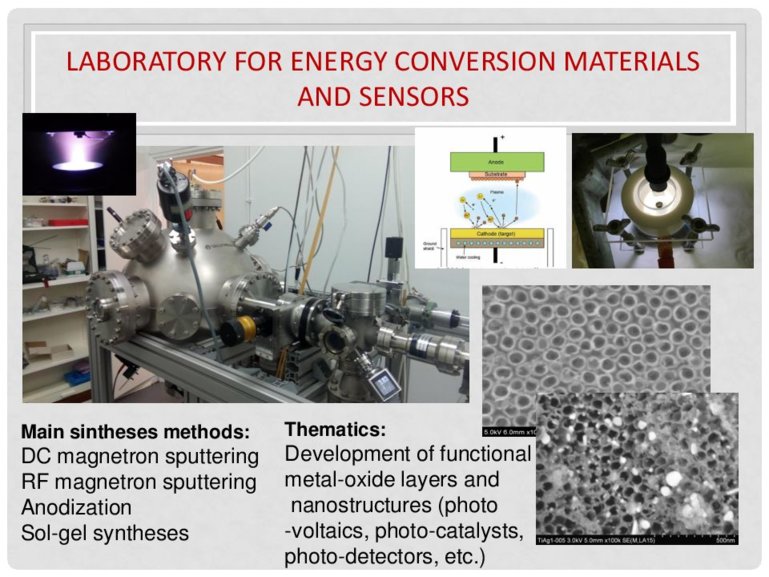The laboratory is formed in March 2016 by joining two groups; one focused on materials for photovoltaic cells and other working on metal oxides nanostructures for different applications as photo-catalysts and sensors but also for applications in photovoltaics. The main focus of the laboratory is based on existing projects Croatian Science Foundation and the European Social Fund within which we explore the possibility of modifying the properties of thin films of metal oxides, primarily of ZnO and TiO2, by adjusting their nanostructures and activating their surfaces by plasma processing but also with different modifiers. The properties are optimized primarily for the use in photovoltaic devices, while the results will be applicable also for other opto-electronic devices, sensors, catalysts etc. In addition to the basic theme of the laboratory, part of its members participate in themes and projects registered with collaborative groups within and outside IRB.
Material preparation techniques: (i) chemical methods and (ii) vacuum deposition by magnetrons sputtering.
(i) The chemical methods (including sol-gel technique and hydrothermal syntheses) enable many possibilities in formation of various nano-structures (e. g. nano-crystals, nano-wires, nano-sheets, nano-tubes) providing larger flexibility for optimization of the preparation and better statistics for understanding the correlation between nano-structure and properties. Nanostructures prepared using chemical methods are deposited in thin layers by „spin-coating“.
(ii) Magnetron sputtering system is laboratory's main instrument. It is of technological importance because the ease of upscale for industrial use, considering that photovoltaic solar cells and sensors assume deposition of the films on large areas. That is why the optimal structural properties found by chemical methods will be goal to be obtained by magnetron sputtering (or PLD techniques in collaboration with group from Institute of Physics).
Characterization techniques of materials: Raman spectroscopy, UV-vis spectroscopy, scanning electron microscopy (SEM), transmission electron microscopy (TEM) in collaboration with international groups (Center for Electron Microscopy, IJS, Ljubljana, Electron microscopy group, FHI-MPG, Berlin), X-ray diffraction (in collaboration with the Faculty of Chemical Engineering and Technology and Faculty of Science, University of Zagreb), impedance spectroscopy (with LFM-DMC-IRB).
PROJECTS
PROJECT MANAGEMENT:
1. 2015-2018 HrZZ (Croatian Science Foundation) project “Zinc Oxide and Titanium Dioxide Nanocomposites for Photovoltaic Application” (IP-2014-09-9419) A. Gajović (668.298,00 kn)
2. 2016-2017 Proof of Concept BICRO project "Multi-functional chamber for electrical measurements", A. Gajović (349.600,00 kn)
3. 2015-2016 European Social Fund project "Titanium dioxide nanostructures for photovoltaic cell, the professional development of young researchers / postdoc" D. Gracin (1.894.000,00 kn).
4. 2017-2018 Croatian-French Bilateral program (Cogito), "Micro-Raman spectroscopy study of bio-ceramic surface composition changes", A. Gajović
5. 2016-2017 Croatia - Germany Bilateral (MZOŠ-DAAD): „In situ growth optimization of 2D chalcogenides based on transition metals (TMDs) for potential applications in electronics and optoelectronics“ A. Gajović (IRB) -M. G. Willinger (FHI-MPG).
6. 2016-2018, Croatia-Serbia Bilateral, "Preparation and characterization of modified TiO2 nanostructured thin films for photovoltaic application", A. Gajović
7. 2016-2017 HAZU Foundation "Perovskites for photovoltaic application", A. Gajović
8. 2015/2016 HAZU Foundation „Persistent photoconductivity in BaTiO3 / TiO2 heterostructures“ A. Gajović (8.000,00 kn).
PARTICIPATION IN PROJECTS:
9. 2014-2018 HrZZ „Bioinspired materijals - mechanisms of formation and interaction” (D. Kralj) – A. Gajović 50%, M. Plodinec 50%
10. 2015-2019 HrZZ “Green synthesis of organopalladium photosensitive compounds" (M. Ćurić), K. Juraić 20%.
11. 2016-2019 HrZZ "Mechanochemical reactivity under controlled conditions of temperature and atmosphere for a clean synthesis of functional materials" (K. Užarević) – D.Gracin 30%.
12. 2015-2017 Croaia - China Bilateral "Mechanochemical organic synthesis: Experimental and theoretical investigation of reaction mechanisms" (V. Štrukil) – sur. D. Garcin.
PARTICIPATION IN THE CENTRE OF EXCELLENCE:
Center of Excellence for Advanced Materials and sensors (CEMS), participating in units
(a) New functional materials: participate A. Gajović and M. Plodinec
(b) Graphene and related 2D structures: participating A. Gajović and M. Plodinec


